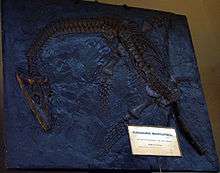Plesiosauria
| Plesiosauria Temporal range: Late Triassic - Late Cretaceous, 203.6–66.0 Ma | |
|---|---|
 | |
| Restored skeleton of Plesiosaurus | |
| Scientific classification | |
| Kingdom: | Animalia |
| Phylum: | Chordata |
| Class: | Reptilia |
| Superorder: | †Sauropterygia |
| Clade: | †Pistosauria |
| Order: | †Plesiosauria de Blainville, 1835 |
| Suborders | |
The Plesiosauria (/ˌpliːsiəˈsɔːriə, -zi-/;[1][2] Greek: πλησίος, plesios, meaning "near to" and Sauria) or plesiosaurs are an order or clade of Mesozoic marine reptiles (marine Sauropsida), belonging to the Sauropterygia.
Plesiosaurs first appeared in the latest Triassic Period, possibly in the Rhaetian stage, about 203 million years ago. to 65 million years ago [3] They became especially common during the Jurassic Period, thriving until their disappearance due to the Cretaceous–Paleogene extinction event at the end of the Cretaceous Period, about 66 million years ago. They had a worldwide oceanic distribution.
Plesiosaurs were among the first fossil reptiles discovered. In the beginning of the nineteenth century, scientists realised how distinctive their build was and they were named as a separate order in 1835. The first plesiosaurian genus, the eponymous Plesiosaurus, was named in 1821. Since then, more than a hundred valid species have been described. In the early twenty-first century, the number of discoveries has increased, leading to an improved understanding of their anatomy, relationships and way of life.
Plesiosaurs had a broad flat body and a short tail. Their limbs had evolved into four long flippers, which were powered by strong muscles attached to wide bony plates formed by the shoulder girdle and the pelvis. The flippers made a flying movement through the water. Plesiosaurs breathed air, and bore live young; there are indications that they were warm-blooded.
Plesiosaurs showed two main morphological types. Some species, with the "plesiosauromorph" build, had (sometimes extremely) long necks and small heads; these were relatively slow and caught small sea animals. Other species, some of them reaching a length of up to seventeen metres, had the "pliosauromorph" build with a short neck and a large head; these were apex predators, fast hunters of large prey. The two types are related to the traditional strict division of the Plesiosauria into two suborders, the long-necked Plesiosauroidea and the short-neck Pliosauroidea. Modern research, however, indicates that several "long-necked" groups might have had some short-necked members or vice versa. Therefore, the purely descriptive terms "plesiosauromorph" and "pliosauromorph" have been introduced, which do not imply a direct relationship. "Plesiosauroidea" and "Pliosauroidea" today have a more limited meaning. The term "plesiosaur" is properly used to refer to the Plesiosauria as a whole, but informally it is sometimes meant to indicate only the long-necked forms, the old Plesiosauroidea.
History of discovery
Early finds
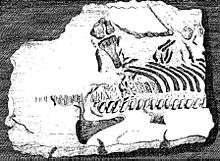
Skeletal elements of plesiosaurs are among the first fossils of extinct reptiles recognised as such. In 1605, Richard Verstegen of Antwerp illustrated in his A Restitution of Decayed Intelligence plesiosaur vertebrae that he referred to fishes and saw as proof that Great Britain was once connected to the European continent.[4] The Welshman Edward Lhuyd in his Lithophylacii Brittannici Ichnographia from 1699 also included depictions of plesiosaur vertebrae that again were considered fish vertebrae or Ichthyospondyli.[5] Other naturalists during the seventeenth century added plesiosaur remains to their collections, such as John Woodward; these were only much later understood to be of a plesiosaurian nature and are today partly preserved in the Sedgwick Museum.[6]
In 1719, William Stukeley described a partial skeleton of a plesiosaur, which had been brought to his attention by the great-grandfather of Charles Darwin, Robert Darwin of Elston. The stone plate came from a quarry at Fulbeck and had been used, with the fossil at its underside, to reinforce the slope of a watering-hole in Elston. After the strange bones it contained had been discovered, it was displayed in the local vicarage as the remains of a sinner drowned in the Great Flood. Stukely affirmed its "diluvial" nature but understood it represented some sea creature, perhaps a crocodile or dolphin.[7] The specimen is today preserved in the Natural History Museum, its inventory number being BMNH R.1330. It is the earliest discovered more or less complete fossil reptile skeleton in a museum collection. It can perhaps be referred to Plesiosaurus dolichodeirus.[6]

During the eighteenth century, the number of English plesiosaur discoveries rapidly increased, although these were all of a more or less fragmentary nature. Important collectors were the reverends William Mounsey and Baptist Noel Turner, active in the Vale of Belvoir, whose collections were in 1795 described by John Nicholls in the first part of his The History and Antiquities of the County of Leicestershire.[8] One of Turner's partial plesiosaur skeletons is still preserved as specimen BMNH R.45 in the British Museum of Natural History; this is today referred to Thalassiodracon.[6]
Naming of Plesiosaurus

In the early nineteenth century, plesiosaurs were still poorly known and their special build was not understood. No systematic distinction was made with ichthyosaurs, so the fossils of one group were sometimes combined with those of the other to obtain a more complete specimen. In 1821, a partial skeleton discovered in the collection of Colonel Thomas James Birch,[9] was described by William Conybeare and Henry Thomas De la Beche, and recognised as representing a distinctive group. A new genus was named, Plesiosaurus. The generic name was derived from the Greek πλήσιος, plèsios, "closer to" and the Latinised saurus, in the meaning of "saurian", to express that Plesiosaurus was in the Chain of Being more closely positioned to the Sauria than Ichthyosaurus, which had the form of a more lowly fish.[10] The name should thus be rather read as "approaching the Sauria" than as "near lizard". Parts of the specimen are still present in the Oxford University Museum of Natural History.[6]
Soon afterwards, the morphology became much better known. In 1823, Thomas Clark reported an almost complete skull, probably belonging to Thalassiodracon, which is now preserved by the British Geological Survey as specimen BGS GSM 26035.[6] The same year, commercial fossil collector Mary Anning and her family uncovered an almost complete skeleton at Lyme Regis in Dorset, England, on what is today called the Jurassic Coast. It was acquired by the Duke of Buckingham, who made it available to the geologist William Buckland. He in turn let it be described by Conybeare on 24 February 1824 in a lecture to the Geological Society of London,[11] during the same meeting in which for the first time a dinosaur was named, Megalosaurus. The two finds revealed the unique and bizarre build of the animals, in 1832 by Professor Buckland likened to "a sea serpent run through a turtle". In 1824, Conybeare also provided a specific name to Plesiosaurus: dolichodeirus, meaning "longneck". In 1848, the skeleton was bought by the British Museum of Natural History and catalogued as specimen BMNH 22656.[6] When the lecture was published, Conybeare also named a second species: Plesiosaurus giganteus. This was a short-necked form later assigned to the Pliosauroidea.

Plesiosaurs became better known to the general public through two lavishly illustrated publications by the collector Thomas Hawkins: Memoirs of Ichthyosauri and Plesiosauri of 1834[12] and The Book of the Great Sea-Dragons of 1840. Hawkins entertained a very idiosyncratic view of the animals, seeing them as monstrous creations of the devil, during a pre-Adamitic phase of history.[13] Hawkins eventually sold his valuable and attractively restored specimens to the British Museum of Natural History.
During the first half of the nineteenth century, the number of plesiosaur finds steadily increased, especially through discoveries in the sea cliffs of Lyme Regis. Sir Richard Owen alone named nearly a hundred new species. The majority of their descriptions were, however, based on isolated bones, without sufficient diagnosis to be able to distinguish them from the other species that had previously been described. Many of the new species described at this time have subsequently been invalidated. The genus Plesiosaurus is particularly problematic, as the majority of the new species were placed in it so that it became a wastebasket taxon. Gradually, other genera were named. Hawkins had already created new genera, though these are no longer seen as valid. In 1841, Owen named Pliosaurus brachydeirus. Its etymology referred to the earlier Plesiosaurus dolichodeirus as it is derived from πλεῖος, pleios, "more fully", reflecting that according to Owen it was closer to the Sauria than Plesiosaurus. Its specific name means "with a short neck".[14] Later, the Pliosauridae were recognised as having a morphology fundamentally different from the plesiosaurids. The family Plesiosauridae had already been coined by John Edward Gray in 1825.[15] In 1835, Henri Marie Ducrotay de Blainville named the order Plesiosauria itself.[16]
American discoveries
In the second half of the nineteenth century, important finds were made outside of England. While this included some German discoveries, it mainly involved plesiosaurs found in the sediments of the American Cretaceous Western Interior Seaway, the Niobrara Chalk. One fossil in particular marked the start of the Bone Wars between the rival paleontologists Edward Drinker Cope and Othniel Charles Marsh.
In 1867, physician Theophilus Turner near Fort Wallace in Kansas uncovered a plesiosaur skeleton, which he donated to Cope.[17] Cope attempted to reconstruct the animal on the assumption that the longer extremity of the vertebral column was the tail, the shorter one the neck. He soon noticed that the skeleton taking shape under his hands had some very special qualities: the neck vertebrae had chevrons and with the tail vertebrae the joint surfaces were orientated back to front.[18] Excited, Cope concluded to have discovered an entirely new group of reptiles: the Streptosauria or "Turned Saurians", which would be distinguished by reversed vertebrae and a lack of hindlimbs, the tail providing the main propulsion.[19] After having published a description of this animal,[20] followed by an illustration in a textbook about reptiles and amphibians,[21] Cope invited Marsh and Joseph Leidy to admire his new Elasmosaurus platyurus. Having listened to Cope's interpretation for a while, Marsh suggested that a simpler explanation of the strange build would be that Cope had reversed the vertebral column relative to the body as a whole. When Cope reacted indignantly to this suggestion, Leidy silently took the skull and placed it against the presumed last tail vertebra, to which it fitted perfectly: it was in fact the first neck vertebra, with still a piece of the rear skull attached to it.[22] Mortified, Cope tried to destroy the entire edition of the textbook and, when this failed, immediately published an improved edition with a correct illustration but an identical date of publication.[23] He excused his mistake by claiming that he had been misled by Leidy himself, who, describing a specimen of Cimoliasaurus, had also reversed the vertebral column.[24] Marsh later claimed that the affair was the cause of his rivalry with Cope: "he has since been my bitter enemy". Both Cope and Marsh in their rivalry named many plesiosaur genera and species, most of which are today considered invalid.
Around the turn of the century, most plesiosaur research was done by a former student of Marsh, Professor Samuel Wendell Williston. In 1914, Williston published his Water reptiles of the past and present.[25] Despite treating sea reptiles in general, it would for many years remain the most extensive general text on plesiosaurs. In 2013, a first modern textbook was being prepared by Olivier Rieppel. During the middle of the twentieth century, the USA remained an important centre of research, mainly through the discoveries of Samuel Paul Welles.
Recent discoveries
Whereas during the nineteenth and most of the twentieth century, new plesiosaurs were described at a rate of three or four genera each decade, the pace suddenly picked up in the 1990s, with seventeen plesiosaurs being discovered in this period. The tempo of discovery accelerated in the early twenty-first century, with about three or four plesiosaurs being named each year.[26] This implies that about half of the known plesiosaurs are relatively new to science, a result of a far more intense field research. Some of this is taking place away from the traditional areas, e.g. in new sites developed in New Zealand, Argentine, Norway, China and Morocco, but the locations of the more original discoveries have proven to be still productive, with important new finds in England and Germany. Some of the new genera are a renaming of already known species, which were deemed sufficiently different to warrant a separate genus name.
In 2002, the "Monster of Aramberri" was announced to the press. Discovered in 1982 at the village of Aramberri, in the northern Mexican state of Nuevo León, it was originally classified as a dinosaur. The specimen is actually a very large plesiosaur, possibly reaching 15 m (49 ft) in length. The media published exaggerated reports claiming it was 25 metres (82 ft) long, and weighed up to 150,000 kilograms (330,000 lb), which would have made it among the largest predators of all time. This error was dramatically perpetuated in BBC's documentary series Walking with Dinosaurs, which also prematurely classified it as a Liopleurodon ferox.
In 2004, what appeared to be a completely intact juvenile plesiosaur was discovered, by a local fisherman, at Bridgwater Bay National Nature Reserve in Somerset, UK. The fossil, dated 180 Ma by the ammonites associated with it, measured 1.5 metres (4 ft 11 in) in length, and may be related to Rhomaleosaurus. It is probably the best preserved specimen of a plesiosaur yet discovered.[27][28][29]
In 2006, a combined team of American and Argentinian investigators (the latter from the Argentinian Antarctic Institute and the La Plata Museum) found the skeleton of a juvenile plesiosaur measuring 1.5 metres (4 ft 11 in) in length on Vega Island in Antarctica.[30] The fossil is currently on display as the geological museum of South Dakota School of Mines and Technology.
In 2008, fossil remains of an undescribed plesiosaur that was named Predator X, now known as Pliosaurus funkei, were unearthed in Svalbard.[31] It had a length of 12 m (39 ft),[31] and its bite force of 149 kilonewtons (33,000 lbf) is one of the most powerful known.[32]
Not only has the number of field discoveries increased, but also, since the 1950s, plesiosaurs have been the subject of more extensive theoretical work. The new method of cladistics has, for the first time, allowed the exact calculation of their evolutionary relationships. Several hypotheses have been published about the way they hunted and swam, incorporating general modern insights about biomechanics and ecology. The many recent discoveries have tested these hypotheses and given rise to new ones. The increasing scientific interest in the group has been called a "plesiosaur renaissance".
Evolution
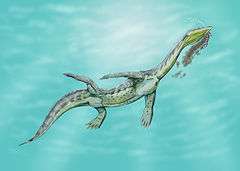
The Plesiosauria have their origins within the Sauropterygia, a group of perhaps archosauromorph reptiles that returned to the sea. An advanced sauropterygian subgroup, the carnivorous Eusauropterygia with small heads and long necks, split into two branches during the Upper Triassic. One of these, the Nothosauroidea, kept functional elbow and knee joints; but the other, the Pistosauria, became more fully adapted to a sea-dwelling lifestyle. Their vertebral column became stiffer and the main propulsion while swimming no longer came from the tail but from the limbs, which changed into flippers.[33] The Pistosauria became warm-blooded and viviparous, giving birth to live young.[34] Early, basal, members of the group, traditionally called "pistosaurids", were still largely coastal animals. Their shoulder girdles remained weak, their pelves could not support the power of a strong swimming stroke, and their flippers were blunt. Later, a more advanced pistosaurian group split off: the Plesiosauria. These had reinforced shoulder girdles, flatter pelves, and more pointed flippers. Other adaptations allowing them to colonise the open seas included stiff limb joints; an increase in the number of phalanges of the hand and foot; a tighter lateral connection of the finger and toe phalanx series, and a shortened tail.
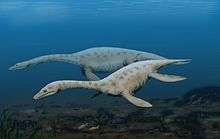
From the earliest Jurassic, the Hettangian stage, a rich radiation of plesiosaurs is known, implying that the group must already have diversified in the Late Triassic; of this diversification, however, only a few very basal forms have been discovered. The subsequent evolution of the plesiosaurs is very contentious. The various cladistic analyses have not resulted in a consensus about the relationships between the main plesiosaurian subgroups. Traditionally, plesiosaurs have been divided into the long-necked plesiosauroidea and the short-necked pliosauroidea. However, modern research suggests that some generally long-necked groups might have had short-necked members. To avoid confusion between the phylogeny, the evolutionary relationships, and the morphology, the way the animal is built, long-necked forms are therefore called "plesiosauromorph" and short-necked forms are called "pliosauromorph", without the "plesiosauromorph" species necessarily being more closely related to each other than to the "pliosauromorph" forms.[35]
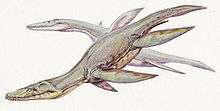
The latest common ancestor of the Plesiosauria was probably a rather small short-necked form. During the earliest Jurassic, the subgroup with the most species was the Rhomaleosauridae, a possibly very basal split-off of species which were also short-necked. Plesiosaurs in this period were at most five metres (sixteen feet) long. By the Toarcian, about 180 million years ago, other groups, among them the Plesiosauridae, became more numerous and some species developed longer necks, resulting in total body lengths of up to ten metres (33 feet).[36]
In the middle of the Jurassic, very large Pliosauridae evolved. These were characterized by a large head and a short neck, such as Liopleurodon and Simolestes. These forms had skulls up to three metres (ten feet) long and reached a length of up to seventeen metres (55 feet) and a weight of ten tonnes. The pliosaurids had large, conical teeth and were the dominant marine carnivores of their time. During the same time, approximately 160 million years ago, the Cryptoclididae were present, shorter species with a long neck and a small head.
The Leptocleididae radiated during the Early Cretaceous. These were rather small forms that, despite their short necks, might have been more closely related to the Plesiosauridae than to the Pliosauridae. Later in the Early Cretaceous, the Elasmosauridae appeared; these were among the longest plesiosaurs, reaching up to fifteen metres (fifty feet) in length due to very long necks containing as many as 76 vertebrae, more than any other known vertebrate. Pliosauridae were still present as is shown by large predators, such as Kronosaurus.
At the beginning of the Late Cretaceous, the Ichthyosauria became extinct; perhaps a plesiosaur group evolved to fill their niches: the Polycotylidae, which had short necks and peculiarly elongated heads with narrow snouts. During the Late Cretaceous, the elasmosaurids still had many species.
All plesiosaurs became extinct as a result of the K-T event at the end of the Cretaceous period, approximately 66 million years ago.[37]
Relationships
In modern phylogeny, clades are defined groups that contain all species belonging to a certain branch of the evolutionary tree. One way to define a clade is to let it consist of the last common ancestor of two such species and all its descendants. Such a clade is called a "node clade". In 2008, Patrick Druckenmiller and Anthony Russell in this way defined Plesiosauria as the group consisting of the last common ancestor of Plesiosaurus dolichocheirus and Peloneustes philarchus; and all its descendants.[38] Plesiosaurus and Peloneustes represented the main subgroups of the Plesiosauroidea and the Pliosauroidea and were chosen for historical reasons; any other species from these groups would have sufficed.
Another way to define a clade is to let it consist of all species more closely related to a certain species that one in any case wishes to include in the clade, than to another species that one to the contrary desires to exclude. Such a clade is called a "stem clade". Such a definition has the advantage that it is easier to include all species with a certain morphology. Plesiosauria was in 2010 by Hillary Ketchum and Roger Benson defined as such a stem-based taxon: "all taxa more closely related to Plesiosaurus dolichodeirus and Pliosaurus brachydeirus than to Augustasaurus hagdorni". Ketchum and Benson (2010) also coined a new clade Neoplesiosauria, a node-based taxon that was defined by as "Plesiosaurus dolichodeirus, Pliosaurus brachydeirus, their most recent common ancestor and all of its descendants".[39] Neoplesiosauria very likely is materially identical to Plesiosauria sensu Druckenmiller & Russell and was meant to be a replacement of this concept.
Benson et al. (2012) found the traditional Pliosauroidea to be paraphyletic in relation to Plesiosauroidea. Rhomaleosauridae was found to be outside Neoplesiosauria, but still within Plesiosauria. The early Carnian pistosaur Bobosaurus was found to be more advanced than Augustasaurus in relation to the Plesiosauria and therefore it represents by definition the oldest known plesiosaur. This analysis focused on basal plesiosaurs and therefore only one derived pliosaurid and one cryptoclidian were included, while elasmosaurids weren't included at all. A more detailed analysis published by both Benson and Druckenmiller in 2014 was not able to resolve the relationships among the lineages at the base of Plesiosauria.[40]
The following cladogram follows an analysis by Benson & Druckenmiller (2014).[40]
